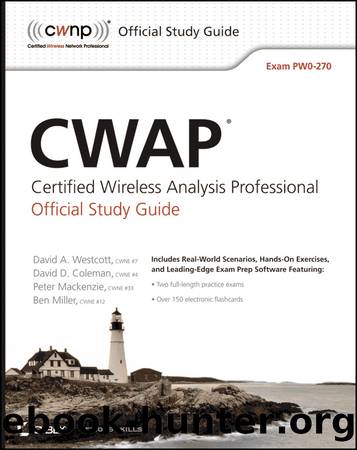CWAP Certified Wireless Analysis Professional Official Study Guide by David A. Westcott & David D. Coleman & Peter Mackenzie & Ben Miller

Author:David A. Westcott & David D. Coleman & Peter Mackenzie & Ben Miller
Language: eng
Format: epub
Publisher: 2011 by Wiley Publishing, Inc., Indianapolis, Indiana
Published: 2011-03-04T16:00:00+00:00
Remember that WEP encrypts the MSDU upper-layer payload that is encapsulated in the frame body of an MPDU. The MSDU payload has a maximum size of 2,304 bytes. Because the IV adds 4 octets and the ICV also adds 4 octets, when WEP is enabled, the entire size of the body inside an 802.11 data frame is expanded by 8 bytes to a maximum of 2312 bytes. In other words, WEP encryption adds 8 bytes of overhead to an 802.11 MPDU.
Figure 9-6: WEP MPDU format
TKIP
TKIP is an enhancement of WEP. Like WEP, TKIP uses the ARC4 algorithm for performing its encryption and decryption processes. The TKIP enhancements were also intended to address the many known weaknesses of WEP. TKIP uses dynamically created encryption keys as opposed to the static keys. Any two radios use a 4-Way Handshake process to create dynamic unicast keys that are unique to those two radios.
Figure 9-7 shows the TKIP encryption and data integrity process. It will be helpful to refer to this figure as you read about the steps TKIP performs.
TKIP starts with a 128-bit temporal key. An often-asked question is “Where does the 128-bit temporal key come from?” The answer is that the 128-bit temporal key is a dynamically generated key that comes from a 4-Way Handshake creation process. This key is identical on the AP and client pair. The 128-bit temporal key can either be a pairwise transient key (PTK) used to encrypt unicast traffic or a group temporal key (GTK) used to encrypt broadcast and multicast traffic.
After the appropriate 128-bit temporal key (pairwise or group) is created, the two-phase key-mixing process begins. A 48-bit TKIP sequence counter (TSC) is generated and broken into 6 octets labeled TSC0 (least significant octet) through TSC5 (most significant octet). Phase 1 key mixing combines the 128-bit temporal key (TK) with the TSC2 through TSC5 octets of the TSC as well as the transmit address (TA). The TA is the MAC address of the transmitting 802.11 radio. The output of the Phase 1 key mixing is the creation of the TKIP-mixed transmit address and key (TTAK).
After the TTAK is generated, the Phase 2 key mixing can begin. Phase 2 key mixing combines the TTAK with the TSC0 and TSC1 octets of the TSC with the 128-bit TK. The output of the Phase 2 key mixing is referred to as the WEP seed. This WEP seed is then run through the ARC4 algorithm, and the keystream is created. The WEP seed is represented as a WEP IV and 104-bit WEP key when fed into the ARC4 algorithm. You may often hear TKIP referenced as using a 48-bit IV. During the Phase 2 key mixing process, TKIP encodes the TSC value from the sender as a WEP IV and an extended IV. The encoding of the 48-bit TSC effectively creates a 48-bit IV.
The two-phase key-mixing process can be summarized as follows:
TTAK = Phase 1 (TK, TA, TSC)
WEP seed = Phase 2 (TTAK, TK, TSC)
Download
This site does not store any files on its server. We only index and link to content provided by other sites. Please contact the content providers to delete copyright contents if any and email us, we'll remove relevant links or contents immediately.
Kotlin in Action by Dmitry Jemerov(17183)
Grails in Action by Glen Smith Peter Ledbrook(15389)
Sass and Compass in Action by Wynn Netherland Nathan Weizenbaum Chris Eppstein Brandon Mathis(13264)
Azure Containers Explained by Wesley Haakman & Richard Hooper(7499)
Configuring Windows Server Hybrid Advanced Services Exam Ref AZ-801 by Chris Gill(7496)
Running Windows Containers on AWS by Marcio Morales(7051)
Microsoft 365 Identity and Services Exam Guide MS-100 by Aaron Guilmette(5434)
Microsoft Cybersecurity Architect Exam Ref SC-100 by Dwayne Natwick(5272)
Combating Crime on the Dark Web by Nearchos Nearchou(5018)
The Ruby Workshop by Akshat Paul Peter Philips Dániel Szabó and Cheyne Wallace(4701)
Management Strategies for the Cloud Revolution: How Cloud Computing Is Transforming Business and Why You Can't Afford to Be Left Behind by Charles Babcock(4546)
Python for Security and Networking - Third Edition by José Manuel Ortega(4274)
The Age of Surveillance Capitalism by Shoshana Zuboff(4243)
Learn Wireshark by Lisa Bock(4175)
Learn Windows PowerShell in a Month of Lunches by Don Jones(4069)
The Ultimate Docker Container Book by Schenker Gabriel N.;(3919)
Ember.js in Action by Joachim Haagen Skeie(3660)
DevSecOps in Practice with VMware Tanzu by Parth Pandit & Robert Hardt(3608)
Windows Ransomware Detection and Protection by Marius Sandbu(3576)
